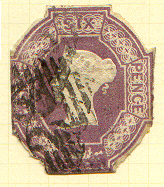British embossed postage stamps facts for kids
The embossed postage stamps of the United Kingdom are super cool and unique stamps from the time of Queen Victoria. They were made between 1847 and 1854. These stamps were special because of how they were made, the paper they used, and even their sticky back!
Contents
Special Stamps for Special Mail
These unique stamps were made in three different values. They were used for more expensive mail, like letters sent to other countries or registered mail (which means it was tracked).
- 1 Shilling (green): This was the first British stamp to be worth more than 2 pence! It came out on September 11, 1847.
- 10 Pence (brown): This stamp was released on November 6, 1848.
- 6 Pence (mauve/lilac/purple): This one appeared on March 1, 1854.
How They Were Made: Embossing
These stamps were made using a special method called embossing. Think of it like a raised design.
The Embossing Process
The metal plates (called dies) used for printing had parts of the stamp design cut into them, making them lower. When the paper was pressed onto these dies, the parts that were cut away didn't get any ink. This made the design, like the Queen's hair or her crown, look raised and colorless. The different depths of the cuts created the detailed look.
The Master Dies
A famous engraver named William Wyon created the main design, called the master die. He based it on a medal he had made in 1837. Fun fact: This was the same design used for the head on the very first postage stamp, the Penny Black!
The first master die didn't show a small curl of hair at the back of Queen Victoria's neck. This original design was used for coins at the Royal Mint, but not for these stamps.
Later, smaller dies were made from the master die, and the little curl of hair was added. Because it was added separately, the curl looks a bit different on each stamp value. Also, a special die number with the letters "W W" (for William Wyon) was added near the base of Queen Victoria's neck.
Special Paper for Stamps
The paper used for these stamps was also quite unique!
Silk Thread Paper
For the 10 pence and 1 shilling stamps, a special paper called Dickinson silk thread paper was used. This paper had tiny blue silk threads mixed right into it when it was made. You can sometimes see these threads in the stamps!
Watermarked Paper
The 6 pence stamp used a different kind of paper. It had a watermark, which is a faint design you can see when you hold the paper up to the light. This watermark showed the letters "V R" (for Victoria Regina, meaning Queen Victoria) and was placed so that the full "V R" appeared on each stamp.
Sticky Backs: Tinted Gum
Most stamps have a clear, colorless gum (the sticky part) on the back. But the 6 pence stamp was different!
Why Tinted Gum?
The 6 pence stamp sometimes had a slightly colored gum. This happened after a mistake was made where some stamps were accidentally printed on the gummed side of the paper. To prevent this from happening again, they started adding a light tint to the gum. Before this, the gum was always clear.
How They Were Printed
These stamps were printed one at a time, which was a very slow process!
One Stamp at a Time
The printing presses used for these embossed stamps could only print one stamp at a time. Because of this, the stamps on a sheet weren't always perfectly spaced. Sometimes they were far apart, and sometimes they were very close, even overlapping! This is why finding stamps with nice, even borders all around them is quite rare and valuable.
The stamps were printed at a place called Somerset House. Early stamp collectors sometimes cut these stamps into special shapes, keeping only the raised central design. But stamps that were cut into a neat square shape are much more valuable today!
New Stamps Take Over
In 1856, the cost of sending mail to Europe went down. Because of this, the unique embossed stamps were replaced with newer, different kinds of stamps that were easier and faster to print.


